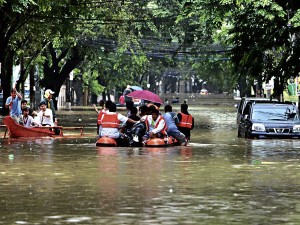With the torrential rains earlier this week, Metro Manila and several provinces in Luzon virtually became a huge body of water. With the floods come another problem which can probably be more devastating than the immediate effects they bring. Floods can be a potential source of many water-borne diseases, such as typhoid fever, cholera, leptospirosis and hepatitis A. It can also increase the risk of vector- or carrier-borne diseases, such as malaria and dengue hemorrhagic fever. Outbreaks have been reported when massive floods occur.
Every time it floods, we see people, especially children, swimming in flood waters. There should be an ordinance banning this because I’m sure these children have the slightest inkling what risk they’re exposing themselves to. Aside from the risk of acquiring a bacterial or protozoal infection, there are also other water-borne diseases which may be contracted through direct contact with polluted waters. These include wound infections, dermatitis, conjunctivitis, and ear, nose and throat infections. Although these diseases are not epidemic-prone, they can make these children really sick and unable to go back to school when classes resume.
Although flooding increases risk of infection and disease, experts from the World Health Organization (WHO) note that this risk is relatively low unless there is significant population displacement or when water sources are compromised. When these happen, a disease outbreak is likely to happen.
It is assuring that our Department of Health (DOH) has a flood-disease control program in place to prevent outbreaks. The DOH and other government agencies should also closely monitor the flooding of garbage and sewage treatment plants because this can rapidly contaminate not only flood water but river water as well.
A potentially serious epidemic-prone infection which can be transmitted directly from contaminated water is leptospirosis, a type of bacterial disease obtained in flood water contaminated with rat urine. The DOH has already activated its leptospirosis alert this week. Those with open wounds have a higher risk of getting infected because of direct contact with contaminated floodwater.
Health Assistant Secretary Eric Tayag advised people in flooded areas to go immediately to the hospital at the first sign of fever so leptospirosis could be ruled out. The fever is usually accompanied by muscle pains, headache and reddish eyes. In late stages, afflicted individuals may experience yellowish body discoloration, dark-colored urine, light stool and diminished urine output. Kidney failure, liver and brain damage may follow in some. In late stages, patients require dialysis to tide them over until the infection is controlled.
Leptospirosis is really bad news, but the good news is that it can be prevented by a simple antibiotic prophylaxis—taking doxycycline 200 mg, one capsule once weekly. The DOH is giving out this antibiotic for free. For residents in flood-affected areas, it is advisable that they take this antibiotic prophylaxis. Medical teams from the DOH are now conducting mass prophylaxis in various areas in Metro Manila and Luzon.
Contrary to popular belief, tetanus is not common after injury from flooding, and the WHO and our DOH do not recommend mass tetanus vaccination programs for prophylaxis when massive floods occur. However, they recommend tetanus boosters for previously vaccinated people who sustain wounds, particularly deep punctured wounds. Tetanus immune globulin (Hypertet) is also recommended in treating wounds in people who have not been actively vaccinated and those whose wounds are highly contaminated.
Children and the elderly can also develop hypothermia if trapped in floodwaters for a long period of time. We see people on television staying on the roofs exposed to the elements when the floods have reached critical levels in their houses. Yet, when the rescuers come, they refuse to budge, preferring to stay put to guard their belongings. They could develop hypothermia and they could lose their most valuable belonging—their own life. The floods come and go, and come back again. But one’s life only goes once.


